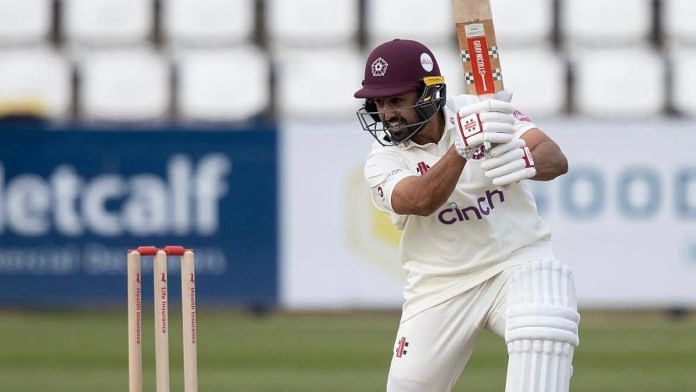New Delhi: In a Vijay Hazare Trophy match recently, Karun Nair made a world record for the most consecutive runs in List A cricket without being dismissed. He surpassed Australia’s James Faulkner and became the first Indian to achieve this incredible feat.
The burly Vidarbha batter has a thing for finishing among the top when it comes to the record books—he is only the second India batter to have scored a triple ton after Virender Sehwag and the quickest batsman to score a maiden triple century in Test cricket’s history.
But that was seven long years ago.
Since then, it’s been a comeback that’s just not culminating in the return of his India Test cap. Shubhman Gill, Shreyash Iyer, and Washington Sunder among many others have debuted since Nair last played a Test. At 33, time is ticking for him even as the spirited cricketer is making his bat talk and attracting national selectors with his performances.
“I am determined to make a comeback in the Indian Test team,” Nair told ThePrint over the phone.
Following inconsistent performances and limited opportunities, the right-hander disappeared from the national spotlight, leaving fans wondering how a player of such promise faded from the scene so abruptly. The 33-year-old’s cricketing journey has been puzzling—never quite reclaiming a spot in the national team, but refusing to fade into the shadows of history. His wife, his support staff and his coaches are backing him with the hope that luck might be on his side for a change.

“Lack of talent or skills was never an issue with him,” said his wife, Sanaya Tankariwala Nair. “He deserves to play for India again. And, we hope luck is on his side this time.”
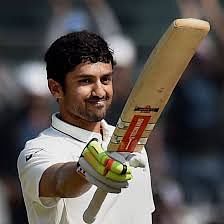
A piece of history
When Nair returned to the dressing room after his unbeaten 303 against England on 19 December 2016 at Chennai’s MA Chidambaram Stadium, the applause was deafening. His phone buzzed endlessly with calls and messages from Indian cricket legends and admirers alike.
The media couldn’t get enough of him. Some lauded it as a “once-in-a-lifetime batting performance,” many described it as an innings of “grit and calculated aggression.”
Following Nair’s innings, India went on to post a mammoth 759 for seven declared against England and winning the match.
Sehwag, India’s only other player to score two Test triple centuries, and West Indies’ star player Chris Gayle welcomed Nair to the club.
“Yay! Welcome to the 300 club, Karun Nair. It was very lonely here for the last 12 years and 8 months. Wishing you the very best Karun! Maza Aa Gaya,” Sehwag wrote.
Nair said when he got down to bat, after Virat Kohli’s dismissal, his intention was “to stabilize the team’s total, not chase personal milestones. You don’t plan for 300—it just happens when you stay in the moment.”
Weeks after the innings, the batter, who hails from Jodhpur, went on to purchase a Ford Mustang with the number plate of the car reading: “KA 03 NA 303”, a mark of his historic inning.
Then came the metaphorical thud. He was dropped after his poor show against a quality Australian attack and could only score a total of 53 runs in the 2017 series. In an interview with the ESPNcrickinfo, he agreed he should have converted the starts.
At the Bengaluru Test in the series, a Mitchell Starc delivery travelling at 153.6 km/h broke Nair’s leg stump into two. It was Nair’s second last appearance in the Indian Test jersey. Nair played his last Test in March 2017 against Australia in Dharamshala. As for the ODIs, he has only played two matches against Zimbabwe in his debut series.
“He is such a good bowler. He has got so many people out like that,” Nair said. “It doesn’t haunt me but I think I could have just defended the ball. What else can you do?”
Later, Nair was selected for the 2018 England tour, but couldn’t find his way into the playing eleven. The selectors and team management instead decided to give Hanuma Vihari a chance.
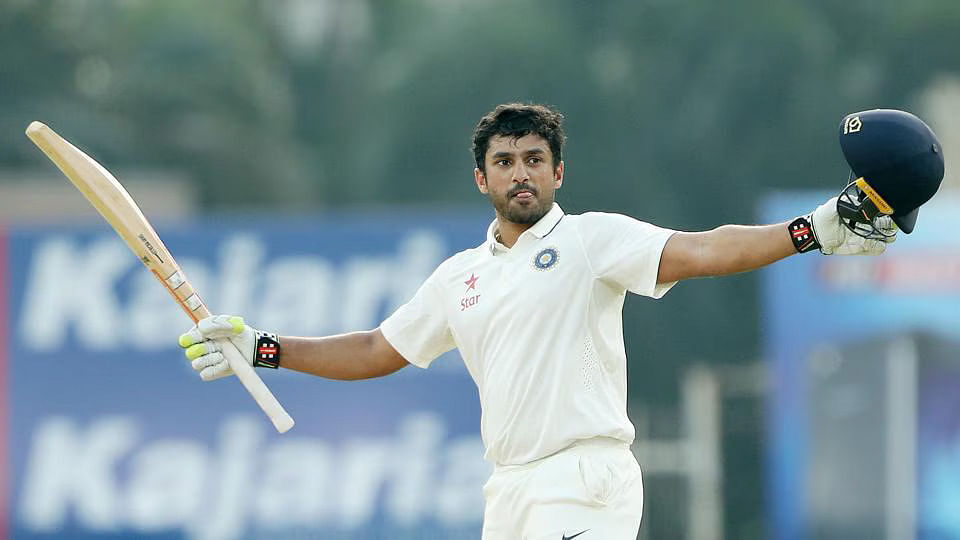
Nair never carried the pressure to replicate the inning again.
“You don’t score 300 every day. I don’t expect myself to keep scoring 300 every day. I never had that expectation or pressure on my mind,” he said.
Sanaya said it took Nair some time to process being dropped from the team, but he eventually made peace with it. She said he realised that his 303-run innings were undeniable proof of his talent.
“I remember him saying, ‘No matter what happens, nothing and no one can take that (historic inning) away from me,’” she recalled.
His journey in the Indian Premier League (IPL) has also been a roller coaster ride. He has represented multiple sides including Royal Challengers Bangalore, Rajasthan Royals, Delhi Capitals and Kings XI Punjab.
In the 76 matches Nair has played in IPL so far, he has scored 1,496 runs with an average of 23.75. In the last three stints (2022, 2020, 2019), Nair played a total of eight matches and scored only 37 runs.
“I cannot pick a favourite. I have loved every franchise I have played for, obviously you enjoy it more when you get to play more games,” said Nair. “When you are part of so many different franchises, so many different coaching setups, you just have to keep adjusting to every coach you come across and what they want you to do. Your role is different in every franchise.”
This year, Nair was bought by Delhi Capitals for Rs 50 lakh.
The Vidarbha batter’s best inning and season in the IPL came when he was playing for DC in 2016-17 season. He scored 638 runs in the two seasons.
His 83 not out against Sunrisers Hyderabad in the 2016 season led the team to victory. It included eighth 4s and three 6s with a strike rate of 140.67. Nair was awarded the ‘Player of the Match’.
Now, he has found that old touch back in the domestic circuit.
“From Maharaja T20 Trophy to Syed Mushtaq Ali T20…Karun has been piling up runs. Next, his focus is on IPL. A few good innings and I think he will have a chance to be considered for the Test squad,” said Sai Prassana, Nair’s trainer.
The batter’s knocking on the Indian team’s door is timely. Virat Kohli and Rohit Sharma’s poor forms, especially in the just concluded Border Gavaskar Trophy, has made their place in the team doubtful. As for the likes of Shubhman Gill and Washington Sunder, their inconsistent performances haven’t cemented their spot in the side.
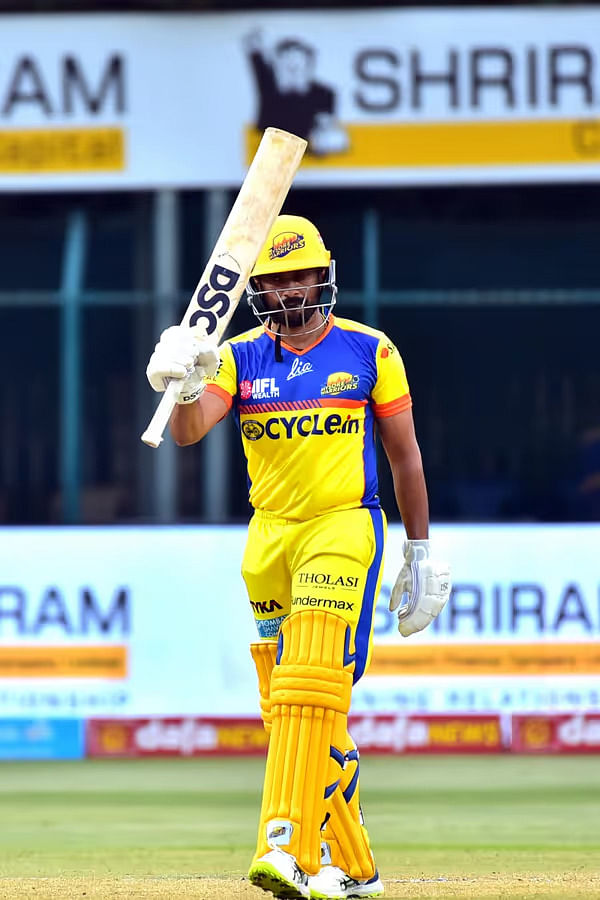
Unwavering support system
At 33, one thing Nair refused to compromise on, even in the toughest moments, was his fitness. He stayed committed to a rigorous daily routine, using the time to transform himself physically and enhance his game.
His trainer, Sai Prassana said that the cricketer sticks diligently to ‘Periodization’, a training program that involves alternating periods of high-intensity and low-intensity training to avoid plateaus and prevent overtraining and extract high performance out of the athlete.
“He never misses a session and the results have been amazing so far,” Prassana said.
Nair’s training is further established into three ‘Ms’ — Macrocycle (a long-term training programme that spans several months or even years), Mesocycle (medium-term training programme that spans several weeks or months, typically used to focus on specific aspects of training such as strength or endurance), and Microcycle (a short-term training programme that spans several days or weeks, typically used to fine-tune training and prepare for a specific competition or event).
“A lot of emphasis on dietary recommendations which he (Karun Nair) strictly follows is to maintain a certain body type for each tournament. Additionally, recovery and rehab is also an integral part,” Prassana added.
His parents — Kaladharan and Prema Nair — have been his biggest strength at every step of the game. They were seated inside an upper-tier box at the M.A. Chidambaram Stadium the day Nair scored his triple-century in 2017.
Though Sanaya, a media professional, initially knew little about cricket, she has developed a deep appreciation for the sport.
“It’s thrilling,” she said, describing Nair’s playing style as selfless—a quality she admires immensely.
“He always plays for the team, not chasing personal milestones. If the team requires quick runs, he’s willing to take the risk of losing his wicket,” she said, adding that “the rope could have been extended” for his career.
Watching Karun Nair grapple with emotional struggles wasn’t easy for his family.
As Sanaya recalled, the initial phase was filled with questions—“Why me? Why did this happen to me?”
His former coach RX Murali also said “it took a massive toll on him.” It hampered his confidence; his emotional balance.
“No one knew why he was dropped. There was no communication,” Murali said. “Karun kept wondering: ‘What have I done wrong?’”
But once he moved past those doubts, he was back to what he does best—amass runs. He rebuilt his game, one inning at a time.
“I’m a calm and composed person. I don’t let emotions sway me too high or too low,” Nair said, reflecting on his ability to navigate challenging times.
Now parents to a three-year-old son and a one-year-old daughter, Sanaya said Nair is a hands-on father.
“Despite his packed schedule, he always makes time for us, whether through quick visits or constant video calls. He manages to be there for cricket and family,” she said.
Also read: In Jasprit Bumrah, India has found its era-defining cricketer after Sachin, Kapil, Gavaskar
‘Management’s soft hand’
Nair was just 12-and-a-half years old when Murali first noticed his talent during a Karnataka under-14 match. The Karnataka team was playing a series of friendly matches against a U-16 team from another state, and young Nair left an unforgettable impression.
“I remember it clearly. He scored a century with just two main shots—a glide-through point and a flick. It was amazing to watch him construct a century like a seasoned pro with such a limited arsenal,” Murali recalled, calling Nair a “prolific run-getter.”
“We rarely had to work on his technique. Wherever he played, he just kept piling on the runs.”
By the time he was 17, selectors were already considering him for the Ranji Trophy.
Timing and opportunity have a significant role in the game. The presence of stalwarts such as MS Dhoni once limited opportunities for wicketkeepers. Similarly, Indian cricket, bursting with talent, often sidelines players simply because they don’t fit into the team structure.
Sports journalist Manuja Veerappa blames the team management, both at the state and national levels, for giving Nair a soft hand.
“The expectations skyrocketed after his 303 not out,” Veerappa said. “KSCA and the selectors could have handled him with more care. What he needed during that phase was mental fortitude, not constant pressure. No one doubts Karun’s talent, but the management around him didn’t rise to the occasion. As a result, Nair ended up pushing himself harder during a slump when what he really needed was a chance to recalibrate.”
Former cricketer Aakash Chopra has time and again brought Nair into his conversations and tweets while taking a dig at the team management and selectors.
When the Indian team management dropped Ishan Kishan from the playing XI for an ODI match in January 2023, after he had scored the fastest ODI double-century in history against Bangladesh, Chopra tweeted: “It’s not often that you score a double-century and get benched in the following game. But then, Indian cricket had benched the triple-centurion in the next game too. Ishan today. Karun Nair back then.”
In an interview with a sports channel, Chopra said that Nair was not able to make a career “because he did not get continuity.”
Nair’s exclusion from the home Tests against West Indies in 2018 raised a few eyebrows but the chairman of selectors MSK Prasad said that the player himself was already given the reason.
“I personally spoke to Karun soon after the selection of the Test team against the West Indies and also told the ways to make a comeback. The selection committee is very very clear with regard to the communication process,” Prasad told PTI.
Prasad had said that his colleague Devang Gandhi had spoken to the middle-order batsman in England to keep him motivated and wait for his opportunities.
A Karnataka coach suggested that “likability” also plays a part.
“Skills are just one aspect. How you present yourself, how you talk, and even how you look—these intangible factors often weigh heavily.”
‘Talent unexplored’
Journalist Manuja Veerappa’s 2021 article, How Long a Rope Will Karun Nair Get?, strained her rapport with the cricketer. A day after the article, Punjab bowlers bowled out Karnataka for a humiliating 87 to set up a 9-wicket win in the quarter-final of the Syed Mushtaq Ali Trophy. Nair’s contribution was 12 runs.
“We have a cordial relationship now,” said Veerappa, who has been covering Karnataka sports for the last two decades.
Despite remaining active in cricket, some articles labeled him as “India’s forgotten triple centurion.” Media stories constantly reminded him—and the world—of that one monumental innings. With every update on his matches, the “triple centurion” tag followed him, overshadowing his broader identity as a cricketer and reducing him to just that historic achievement.
Sanaya has no hard feelings against the negative press.
“It’s their job. But, it does bother if people say negative things about your loved ones,” she said. “At times I found it a little exaggerated as well.”
Veerappa thinks that during his slump, the selectors should have given him a breather—and that Nair himself could have benefited from taking a step back.
She described Nair as a “determined, hardworking, and immensely talented cricketer with a strong sense of purpose.” And his cricketing journey “potential unfulfilled.”
The journalist revealed that she was present in the stadium when Nair scored his domestic triple hundred against Tamil Nadu in the Ranji Trophy final in 2015. He became the first batsman in 68 years to score a triple century in a Ranji Trophy final. The first one to do so was Baroda’s Gul Mohammad (319) in the final of the 1946-47 season.
After the interview was wrapped, she recalled, Nair went back to the pitch and took a selfie with the stumps.
“He was someone who valued everything that came his way,” Veerappa said. “He had so much to offer to Indian cricket, especially in red ball cricket. A different time; a different situation – he probably would have gotten a longer run.”
Although Veerappa’s articles contained some harsh critiques, she never questioned Nair’s gameplay.
In fact, she is impressed with his performance over the past two years.
“Karun, who was locked in the wilderness and treasure of 303 (not out) innings and the bitterness of not being given a good run in the Indian team, broke that baggage,” she said.
‘Comeback in the making’
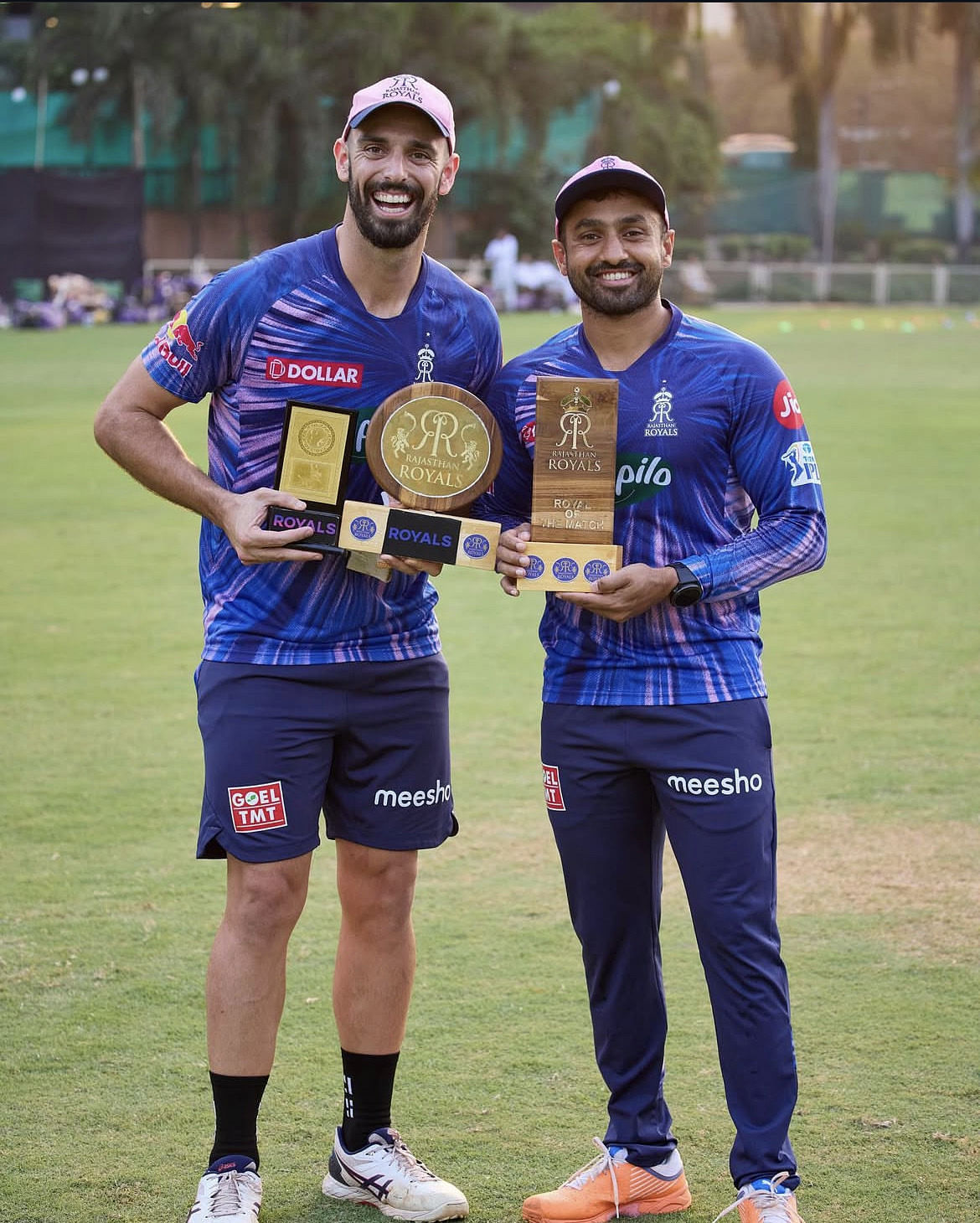
Trainer Sai Prassana is confident that the 33-year-old is on the verge of a remarkable comeback to the Test team.
Prassana revealed that a thorough ‘needs analysis’ is conducted before each season, considering the game’s demands and seasonal requirements, according to which his fitness regime is adjusted. He ensures to “prime up” the cricketer before every tournament.
“Nair doesn’t play like a 33-year-old; he plays like a 25-year-old,” Prassana said. “The fitter he gets, the greater his chances of making a successful return.”
Fitness, as per Prassana, was never Nair’s weak point.
“The Yoyo test is the gold standard of fitness and he was among the top scorers,” he said.
Reflecting on a challenging phase in Nair’s career—a 56-match slump without a century in domestic matches —Murali said the cricketer chose to shed the ‘victim’ mindset and focus solely on improvement.
“When he came back to train (after being dropped from the Indian team), it was about pressing the restart button,” says Murali, who has been coaching for 28 years.
“He would bat for four hours straight, reconnecting with the approach he grew up with. It wasn’t about perfecting shots or techniques; it was about finding peace within himself.”
That inner calm proved instrumental, as the runs began to flow again.
What sets Nair apart, according to Murali, is his incredible ability to manipulate the game.
“He’s one of the few cricketers who can manipulate the field and bowlers to deliver the balls he wants. It’s an amazing skill,” Murali said.
He is deeply aware of the hard work Nair has invested, often unnoticed by the larger world. With admiration and hope, Murali said he hopes the batter gets another shot at the highest level.
But, for Veerappa, the ship has sailed long back.
“The cricket circle is brimming with talent, it’s a little difficult now because a number of people are waiting to make a comeback,” she said, citing the example of Jalaj Saxena, who last year in November reached an incredible feat of 6000 runs and 400 wickets in the Ranji Trophy.
Despite a tremendous record, Saxena doesn’t even get picked for India A team.
“When I asked the selectors, they said, ‘give me one good reason why at 35 we should take him?’ So, age at this point of time is a huge factor in the Indian cricket team,” she said.
‘Looking for a closure’
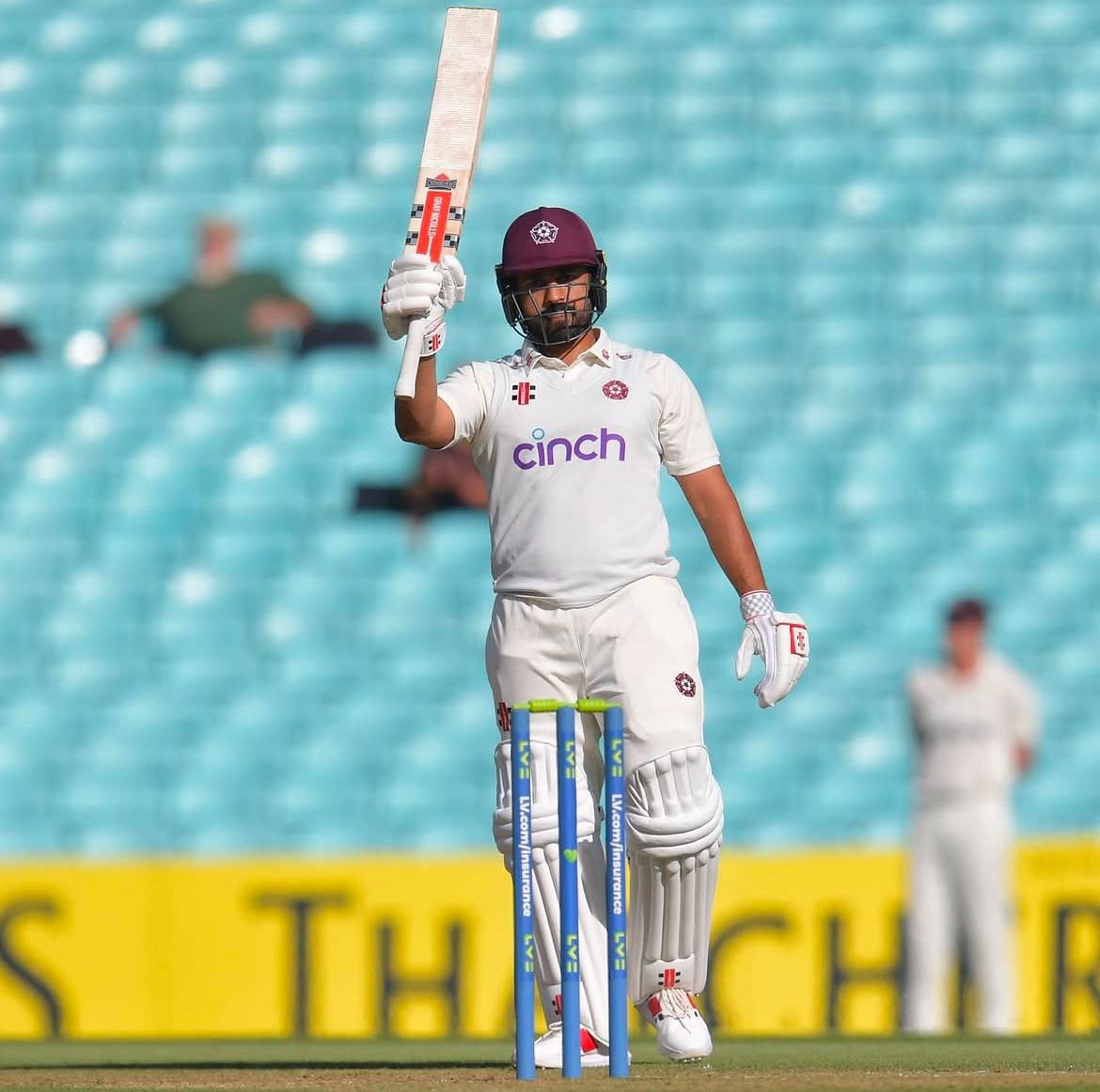
In cricket, age is not just a number. But some have proven that wrong.
From Michael Hussey making his debut at 30 to Fawad Alam making a stunning return to Pakistan’s Test team after an 11-year hiatus, the journey of these players offers a refreshing reminder that talent has no expiry date.
Even in India, whether it’s Murali Karthik’s Test recall at 31 or Pravin Tambe rewriting the books by making his IPL debut at 41, these players have proven that perseverance and passion can still lead to success, no matter when the spotlight finds them. Even Gautam Gambhir, the current India head coach, made his comeback to the Test side at the age of 34 in 2016.
“Magic does happen in life,” Murali said. “And, his journey can inspire all the cricketers who’ve lost hope, as it gives them something to look forward to in their own paths.”
He acknowledged that Nair’s career might last only another 2-3 years, but that’s alright, considering the immense effort he’s put in.
“He’s truly earned it. The question we need to ask ourselves is: should we reward his hard work and achievement, or should we deny him simply because he’s 33?”
(Edited by Anurag Chaubey)



